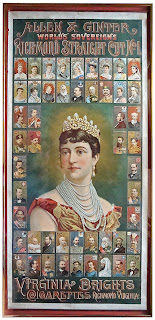If you've had an opportunity to visit my page on trade cards and the evolution of corporate identity (in the right-hand sidebar), you know that Victorians of all ages enjoyed receiving little premium cards with virtually everything they purchased.
The cards of tobacco companies were especially popular because they were often distributed in sets. Above is one of my cards from the 1870s, of Edwin Booth, brother of John Wilkes Booth, and one of the greatest actors of the 19th century. It was distributed by Between the Acts Cigarettes, and would have been included in a set of famous actors.
From my collections, here are two views of a Between the Acts tin from the 1920s. It still has its tissue and all the cigarettes!
 |
| Metropolitan Museum of Art |
The ancestor of the bubblegum card was the tobacco card. Customers going into a tobacco shop might have seen a poster like the one above. It displays a complete set of racing colors, each card of which was in an individual pack. Of course one would have had to smoke a lot of cigarettes to get a complete set.
 |
| Click to enlarge |
I was fortunate enough to find a cigarette poster by the same tobacco company. It features all the rulers of the world, and dates to the 1880s. In the poster, all of the cards are actual size.
These handsome cards from the Jefferson R. Burdick collection, at the Metropolitan Museum of Art, were distributed by the American Tobacco Company in 1911. As tobacco card sets progressed, there became a greater emphasis on sports and athletic teams.
The rarest baseball card is this 1909 Piedmont Honus Wagner, which recently sold for $1.62 million. The card was in early distribution when Honus Wagner objected to being associated with the sale of tobacco, and demanded that all remaining cards be withdrawn.
Perhaps Honus Wagner, who was very popular, was a factor in the transition from tobacco cards to bubblegum cards. More likely it had to do with the gradual death of trade cards in general. In any event, the collecting of baseball cards shifted to a younger demographic, and the cards came to be issued by candy companies.
These striking cards, also from the Metropolitan Museum of Art, were distributed with Cracker Jack candy between 1914 and 1915.
.







Hello Mark:
ReplyDeleteThank you for drawing our attention to your trade card collections as shown in your sidebar. We had not noticed these previously and they are absolutely fascinating.
We can only remember a similar idea in the UK being connected to cards [depicting what we cannot recall]in packets of tea. An album could be sent for in which to house one's collection and, of course, one was always wanting to 'swap' duplicates.
And, what prices some of these cards fetch now!
Hello, Jane and Lance - I'm glad you enjoyed my sidebar presentation of trade cards! I was so very fortunate to begin collecting these beauties when they could be had for 10, 25 and 50 cents. Now they're so much more expensive that I usually just purchase a piece that adds to a set or illustrates some aspect of the advancement of corporate identity.
ReplyDeleteBeautiful cards, Mark. I love looking and reading about them. Once upon a time I had a gorgeous framed collection of cigarette cards featuring pix of golfers. But in an attack of greed (more than need) I sold it.
ReplyDeleteWish I hadn't. :)
I love the card with horse racing colors. I'm a big fan of the turf and thought about collecting silks as a hobby. You never fail to impress, Mark.
ReplyDeleteHope you're enjoying your summer.
Hi, Yvette - I can well imagine your set and how it may have been displayed. Later trade card albums were specially designed for particular sets of cards by the companies that distributed them, and I've seen some of those album pages with golfing sets. They make very handsome framed pieces.
ReplyDeleteThanks for the nice words, Michael! You and Yvette have inspired me to share trade card album sets in a future posting...
ReplyDeleteBrilliant post Mark, along with the your sidebar info on trade cards and the evolution of corporate identity. Just brilliant!
ReplyDeleteAnyes
XX
Thank you, Anyes! Trade card collecting has been one of my most rewarding pleasures.
ReplyDeleteWow - so much history tied up with the graphic and visual interest of these!!
ReplyDeleteHi, Stacey - I was amazed by the quality and beauty of the Burdick collection at the Metropolitan Museum of Art, when I was visiting there last month. And it's telling that baseball cards are recognized by that institution as an American art form.
ReplyDeleteThis art is so special, so perfect in its time and place, a brilliant recollection!
ReplyDeleteHi, Paul - You know, I was never a collector of baseball cards, but now I feel as though I was missing out on something! Certainly if I had lived in Mr. Burdick's era, I too would have been a collector!
ReplyDeleteMark, again you have the most fascinating collections and you write beautifully to illustrate these. I remember my grandfather having a huge collection of cards back in Australia. I remember such things as cricket players, animals, ships and the like being illustrated on them! I wonder what happened to them?
ReplyDeleteThanks, David! I certainly hope your grandfather's cards survived and that somebody is enjoying them. I know that they're at least a rich memory for you!
ReplyDelete